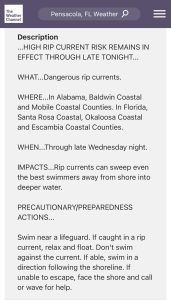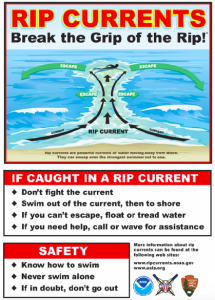
I can only recall being caught in a rip current once, but the memory is so vivid I can picture that beachfront clearly even 32 years later. I was boogie-boarding in an area with huge wave action, and had been riding the waves with delight into the shore for quite a while. At some point, I fell off the board and decided to wade in and rest for a few minutes. I was only in thigh-deep water. But as I walked towards the beach, the water pushed against me with such force that I was stuck exactly where I was. The harder I tried the walk, the more it felt like I was hitting a wall. I’d never encountered a rip current before and didn’t know what to do, so I tried to stand my ground, not panic, and not get pushed out into the Pacific. Finally, someone on the shore noticed my struggle and told me to just hop back on the board and let the waves push me out of that spot. Once I let go trying to fight the water, I was deposited on the beach a few hundred feet down shore from where I was. In hindsight, the whole experience might have lasted 45 seconds, but it obviously left a lasting impression.

It is spring break week here in Pensacola, and for the next 6 weeks or so we will have loads of locals and out-of-town visitors hitting our beaches as spring breaks all over the country cycle through. As we speak, there is a high rip current risk from Gulf Shores, Alabama to Navarre Beach, Florida. There are signs on most beaches explaining what to do—if caught, don’t fight the powerful current, but instead “relax and float.” In a fight or flight situation like this, it can be very difficult to relax. But trust me, even the strongest Olympic swimmer cannot overpower that current. The NOAA website gives a great metaphor of rip currents as fast-moving treadmills you cannot exit unless you step to the side. Floating or swimming parallel to the shore will take you out of it, allowing for safe return to the beach.

So how do rip currents form? Normally, wind and current-drive waves are pushed to the beach in a regular, parallel-to-the shore fashion, breaking on sandbars and the beach. The returning water flows back out to sea. However, if there is a faster path back to the sea—like an opening between sand bars–water will rush back through that gap and form a rip current. The currents don’t typically go very far offshore, and are not very wide. This is why moving sideways allows for an exit to the current. Rip currents can form anywhere, but may be more prevalent near hard structures like piers, jetties, and reefs. To the practiced eye, rip currents can be seen from a distance—they will manifest as a perpendicular line of seafoam going offshore, or a gap in the waves.

Every year, local lifeguards save hundreds of beachgoers caught in rip currents. Many of those rescues are of people who try to wade out to help someone stuck, only to get caught themselves. Nationally, 80% of lifeguard rescues are related to swimmers caught in rip currents. On public beaches, especially those with lifeguard protection, red flags will be flown as a warning of high, strong surf and rip currents. Inevitably, a handful of visitors who have saved money and waited all year for a week at the beach will ignore signs and still try to go out. If you have friends or family coming in town for a beach trip, be sure they are aware of the risks and know what do if they get caught.
 2
2
